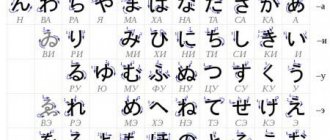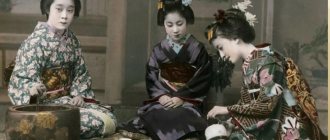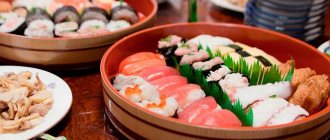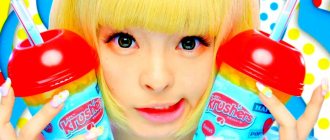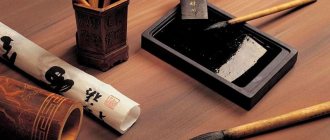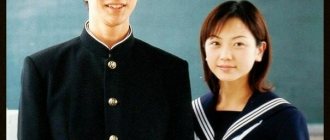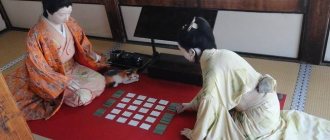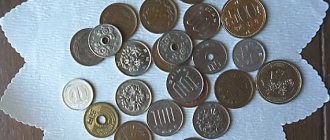Greetings, Friends. Igor Korotkov is with you. You are on the website Venasera.ru. Today we will talk about Japanese writing.
Traditionally, the Japanese language uses a vertical way of writing, i.e. The characters go from top to bottom and the columns go from right to left. This method continues to be widely used in fiction, as well as in newspapers. But in everyday life they usually use the standard, familiar to us, European way of writing , i.e. from left to right from top to bottom.
Writing in the Japanese language is divided into 2 Japanese syllabic alphabet Hiragana and Katakana , as well as kanji (hieroglyphs) .
ひらがな
Hiragana is used to write inflected parts of words, grammatical particles, or words whose hieroglyphic spelling has fallen out of use.
Hiragana characters are characterized by rounded, soft writing. Hiragana (平仮名) is translated from Japanese as “smooth alphabet” - that is, not “angular” like Katakana (片仮名). Hiragana was used by female authors of diaries and novels in the 9th to 12th centuries. Japanese poetry was written with it. Hiragana was a kind of “lightweight” letter, since it was believed that hieroglyphs for women were very difficult.
about how to easily and quickly remember the Hiragana alphabet in this video.
Kanji and Hiragana
So why do sentences have a mixture of kanji and hiragana? Because hiragana is used for grammatical particles and modifiers. Remember that each character represents a meaning, not a sound. So when writing a verb, you use kanji for the base concept and then hiragana to change the pronunciation and add more meaning, such as tense.
For example, the verb miru , meaning "to see" , is written見る, combining the kanji 見 (read mi) with the hiragana る (ru). If you want to change it to the past tense, mita, you should leave the kanji as is and replace る with hiragana た (ta) to get見 た, which means "saw" .
But wait, if everything that can be written in Kanji can also be written in Hiragana, why not just use Hiragana? After all, while the full set of 46 hiragana is larger than the 33-letter Russian alphabet, it is still much more manageable than the 2,000 or so common kanji, knowledge of which serves as the litmus test for complete adult Japanese literacy.
Japanese uses between 3000 (99% coverage) and 4500 (99.9% coverage) characters, but the most popular 2000 characters make up 96% of all characters in the text. To speak Japanese well, you need to know about 2500–3500 kanji. The school covers 2136 kanji.
カタカナ
Another alphabet is katakana , used to write borrowed words from foreign languages. Those. Your name will also be written using the Katakana , because... it's foreign. Also, sometimes katakana is used to write the names of animals, plants, and also as a stylistic device to highlight the desired word.
Literally, Katakana (片仮名) is translated from Japanese as “angular alphabet.” Katakana characters are angular and sharp, in contrast to hiragana characters, which differ significantly in their smoothness. Compare! This is Hiragana and this is Katakana.
We talked about how to easily and quickly remember the Katakana alphabet in this video.
Katakana was invented by monks to rewrite Chinese texts, in particular Buddhist sutras, and just like Hiragana, it originated from Chinese characters, but not from whole characters (as was the case in Hiragana ), but from their parts. Unlike hieroglyphs the Hiragana and Katakana syllabaries convey only sound, without any meaning.
In order not to waste your time, we will not dwell in more detail on the origin of Japanese writing , but will move on to examples.
Get the basics with Go! Go! Nihon
Such a complex system of characters can be a little intimidating, especially for those who are just starting to learn Japanese. But don't worry, there are plenty of great resources for learning language alphabets and characters, from books to phone apps to games!
If you're learning Japanese at home, we have some great articles that might help you: *Best apps for learning Japanese *Self-isolating? Use this time to learn Japanese!
Another great way to learn the basics of Japanese is to take our online course for beginners . We have worked in partnership with Akamonkai Japanese Language School to offer a comprehensive 12-week course, providing a solid foundation of knowledge to develop your language skills. You can find out more about the course here.
For more information, don't hesitate to contact us!
An example of using Japanese alphabets
Now some examples.
As we have already said, the changeable parts of a word are written in Hiragana: for example, there is a verb to look 見る (WORLD), the root of the hieroglyph (i.e. its unchangeable part) is written first -見 (MI) . It will be written in hieroglyphs. This word has a variable part - the ending る, which will change depending on the need, for example, if you need to convey the tense of the verb or the style of politeness. So 見るcan change to 見ます, 見ました, etc. Also, do not forget that grammatical particles in Japanese are also written in Hiragana , for example:私はイーゴリです。 “I am Igor.” In this case, the grammatical particle Ba and the copula Des will be written in Hiragana . My name is not Japanese, i.e. it is borrowed from the Russian language, so it is written in Katakana alphabet. I am Watashi is a Japanese word and it is written in Kanji, i.e. hieroglyph. As you may have noticed, Japanese writing consists of a combination of the Hiragana/Katakana alphabet and hieroglyphs .
Now some examples about Katakana alphabet . Japanese has quite a lot of borrowed words, such as Basu - bus, it is borrowed from English, so it is written in Katakana , the word Pan bread is borrowed from Portuguese, so it is also written in Katakana . Such words are called Gairaigo 外来語.
Now let's look at an example not related to borrowed words. The word “Cat” ( Neko) is written not only in hieroglyphs or Hiragana alphabet , but is also often written in Katakana alphabet - like this. This word is not borrowed, however, animals and plants can also be written in Katakana . And the names of plants are almost always written in katakana , because it’s not even difficult to imagine that it’s much easier to write ツツジ this way than 躑躅. In the post-war reforms, it was recommended to write in katakana , regardless of origin.
Most often, onomatopoeic words are written in Katakana, and figurative words in Hiragana, but this is not so important.
But again, everything is individual, for example, in everyday life such words as Cat, Dog or Cow can often be found in hieroglyphs, and already such words as イノシシ, タコ or ツツジ, etc. Words are most often written in katakana.
I would like to note that when I talk about using Katakana (the theme with animals), do not take everything literally, because... there are a lot of nuances, for example, the type of animal Octopus - Tako, will be written in katakana, and on the store window, as a Takoyaki dish it will be written たこ焼き or タコ焼き, but a simple Japanese will write a Takoyaki dish like this: たこ焼き.
Katakana was also used to write Japanese telegrams when they existed.
The same with general imitative (擬態語) and onomatopoeic (擬声語) words. Usually the Japanese write general imitation words in Hiragana and onomatopoeic words in Katakana, but sometimes they write differently. Don’t focus your attention on this; at the initial stage it is absolutely not important.
Also, sometimes, in various shows, they want to highlight a certain word and make a stylistic highlight of this word, which is usually written in Hiragana or a hieroglyph. For example, it is usually written like this. And they changed it like this.
If we summarize and simplify to the maximum all of the above, then, roughly speaking, Hiragana can be attributed to the function of the main alphabet, and katakana can be attributed to the recording of borrowed words.
How to quickly learn Japanese letters and alphabet
As linguists advise, the most reliable way to learn the alphabet is persistent, purposeful, methodical memorization of symbols combined with constant practice of application. Special applications for practicing signs will help you master writing. There are several programs for telephones and personal computers. Some are available for free, while others have limited or no free functionality. Regular repetition forms a habit, and the speed of recognition increases over time so much that reading turns into a simple task.
Studying Japanese writing
Study method
The easiest way is to master it with a teacher. Private teaching is widespread. There are courses, a set of groups of students. Private study is available, in which the teacher focuses on only one student. Both options are practiced both offline and online. Training with a mentor is the best and most effective option, although it is relatively expensive.
Learning the alphabet on your own does not require such costs. The most effective way is cards (paper or electronic). This is what is implemented in most applications. You can make the cards yourself - it involves rote memory.
How to make cards:
- cut 46 small pieces of paper;
- On each one, write the kana sign on one side, and reading on the reverse;
- pull out cards in random order, recognizing the reading of the sign by the writing.
It is recommended to first master one alphabet, then move on to the second.
In order for kana to be better absorbed, it is necessary to constantly practice the acquired skills by reading simple texts in Japanese, written in alphabet. Textbooks, tutorials, and children's books will help.
Kana cards
漢字
The next video will be about hieroglyphs, but in short, hieroglyphs or Kanji (as they are called in Japan) were borrowed from China in ancient centuries and the Japanese used them for their own needs. Before kanji, Japan did not have its own writing system, because... the same invented alphabet Hiragana and Katakana are derivatives of hieroglyphs .
Hieroglyphs , as a rule, have at least 2 readings: on'yomi (the so-called Chinese reading) and kun'yomi (the so-called Japanese reading). We will talk in more detail about which readings and when to use in the next video.
That's all for today. If you liked the video, like it, tell your friends, subscribe to the channel, and also to our groups on social media. Networks, Igor Korotkov was with you. See you in the next video!
Hiragana alphabet with Russian transcription
Usually, learning the Japanese alphabet using tables with translation into Russian begins with hiragana. It includes 46 characters and is used when writing endings, postfixes, and conjunctions. Sometimes hiragana replaces hieroglyphs. This is not very literate, but acceptable for foreigners and children. The writing system clearly reflects the pronunciation of the word, with minimal differences in spelling and sound.
Features of the alphabet:
- one character – one syllable (except for vowels and “n”);
- one syllable – one constant pronunciation, independent of the position in the word and neighboring elements;
- main consonants are soft;
- hard consonants are obtained by adding additional characters to the symbols of syllables with soft consonants;
- With the consonant “v” only the vowel “a” is used; there are no other syllables with this letter.
Hiragana will use not only readable characters, but also one special one, introduced as an indicator of doubling of the character behind it. Visually it resembles “tsu”, but is half the size of this element. The only purpose of the symbol is to indicate that the next vowel must be pronounced double.
Hiragana and Russian transcription
How is hiragana used?
Since hiragana forms the basis of written Japanese, there are several cases where it plays an important role: Furigana Furigana is, simply put, a guide to the pronunciation of difficult Japanese words, written as small hiragana characters above or to the side of the kanji characters. Kanji are complex Chinese characters that represent entire words and are most often used in texts. If you can't read the kanji, there will most likely be furigana characters nearby for a clue. You can also see furigana in Japanese lessons in the LingQ library.
Suffixes (and Sentence Separators) Suffixes play an important role in Japanese grammar. They are added at the end of a word and thus indicate what part of speech it is - a noun, an adverb or a verb. The most common suffixes are は (wa), が (ga), and を (wo). They also help you understand the flow of words in written text because words are not separated by spaces. The suffix placement and grammatical hiragana (below) show where the word ends. Polyglot Steve Kaufmann made an excellent video on suffixes in Japanese on his YouTube channel.
Hiragana grammar is also an important part of sentence grammatical structure. Since whole words are most often written as kanji characters, hiragana is used to indicate the grammatical role of a word in a sentence, such as tense or participial construction. For example, 勉強 (ben'kyu) means 'learning' in noun form. The present tense of a verb is made by adding している (shiteiru) to the noun, becoming 勉強している (ben'kyū shiteiru) or 'studying'.
